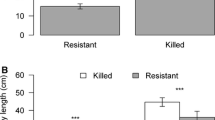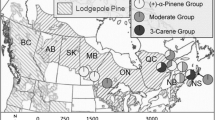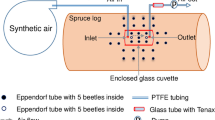Abstract
Secondary attraction to aggregation pheromones plays a central role in the host colonization behavior of the European spruce bark beetle Ips typographus. However, it is largely unknown how the beetles pioneering an attack locate suitable host trees, and eventually accept or reject them. To find possible biomarkers for host choice by I. typographus, we analyzed the chemistry of 58 Norway spruce (Picea abies) trees that were subsequently either (1) successfully attacked and killed, (2) unsuccessfully attacked, or (3) left unattacked. The trees were sampled before the main beetle flight in a natural Norway spruce-dominated forest. No pheromones were used to attract beetles to the experimental trees. To test the trees’ defense potential, each tree was treated in a local area with the defense hormone methyl jasmonate (MeJ), and treated and untreated bark were analyzed for 66 different compounds, including terpenes, phenolics and alkaloids. The chemistry of MeJ-treated bark correlated strongly with the success of I. typographus attack, revealing major chemical differences between killed trees and unsuccessfully attacked trees. Surviving trees produced significantly higher amounts of most of the 39 analyzed mono-, sesqui-, and diterpenes and of 4 of 20 phenolics. Alkaloids showed no clear pattern. Differences in untreated bark were less pronounced, where only 1,8-cineole and (−)-limonene were significantly higher in unsuccessfully attacked trees. Our results show that the potential of individual P. abies trees for inducing defense compounds upon I. typographus attack may partly determine tree resistance to this bark beetle by inhibiting its mass attack.





Similar content being viewed by others
References
Andersson MN, Larsson MC, Schlyter F (2009) Specificity and redundancy in the olfactory system of the bark beetle Ips typographus: single-cell responses to ecologically relevant odors. J Insect Physiol 55:556–567
Andersson MN, Larsson MC, Blazenec M, Jakus R, Zhang Q-H, Schlyter F (2010) Peripheral modulation of pheromone response by inhibitory host compound in a beetle. J Exp Biol 213:3332–3339
Baier P, Bader R, Rosner S (1999) Monoterpene content and monoterpene emission of Norway spruce (Picea abies Karst.) bark in relation to primary attraction of bark beetles (Col, Scolytidae). In: Lieutier F, Mattson WJ, Wagner MR (eds.) Physiology and genetics of tree-phytophage interactions, vol 90. Les Colloques de l’INRA, Gujan (France), pp 249–259
Berryman AA, Dennis B, Raffa KF, Stenseth NC (1985) Evolution of optimal group attack, with particular reference to bark beetles (Coleoptera: Scolytidae). Ecology 66:898–903
Birgersson G, Schlyter F, Löfqvist J, Bergström G (1984) Quantitative variation of pheromone components in the Spruce bark beetle Ips typographus from different attack phases. J Chem Ecol 10:1029–1055
Boone CK, Aukema BH, Bohlmann J, Carroll AL, Raffa KF (2011) Efficacy of tree defense physiology varies with bark beetle population density: a basis for positive feedback in eruptive species. Can J For Res 41:1174–1188
Brignolas F, Lacroix B, Lieutier F, Sauvard D, Drouet A, Claudot AC, Yart A, Berryman AA, Christiansen E (1995) Induced responses in phenolic metabolism in two Norway spruce clones after wounding and inoculations with Ophiostoma polonicum, a bark beetle-associated fungus. Plant Physiol 109:821–827
Byers JA (1996) An encounter rate model of bark beetle populations searching at random for susceptible host trees. Ecol Model 91:57–66
El-Sayed A (2010) The Pherobase: Database of insect pheromones and semiochemicals. In: www.pherobase.com, vol 2009. © 2003–2010 The Pherobase.
Enander G, Svensson L (2007) 3:e rapport. In: Skogsstyrelsens rapport om utvecklingen och bekämpningen av skadeinsekter år 2007. Swedish Forest Agency
Erbilgin N, Krokene P, Christiansen E, Zeneli G, Gershenzon J (2006) Exogenous application of methyl jasmonate elicits defenses in Norway spruce (Picea abies) and reduces host colonization by the bark beetle Ips typographus. Oecologia 148:426–436
Faccoli M, Schlyter F (2007) Conifer phenolic resistance markers are bark beetle antifeedant semiochemicals. Agric For Entomol 9:237–245
Faccoli M, Blazenec M, Schlyter F (2005) Feeding response to host and non-host compounds by males and females of the spruce bark beetle Ips typographus in a tunneling micro assay. J Chem Ecol 31:745–759
Franceschi VR, Krokene P, Christiansen E, Krekling T (2005) Anatomical and chemical defenses of conifer bark against bark beetles and other pests. New Phytol 167:353–375
Hedgren PO, Schroeder LM (2004) Reproductive success of the spruce bark beetle Ips typographus (L.) and occurrence of associated species: a comparison between standing beetle-killed trees and cut trees. For Ecol Manag 203:241–250
Jakuš R (1998) Types of bark beetle (Coleoptera: Scolytidae) infestation in spruce forest stands affected by air pollution, bark beetle outbreak and honey fungus (Armillaria mellea). Anz Schädlingsk 71:41–49
Kamm CD, Tawara JN, Stermitz FR (1998) Spruce budworm larval processing of piperidine alkaloids from spruce needles. J Chem Ecol 24:1153–1160
Kopper BJ, Illman BL, Kersten PJ, Klepzig KD, Raffa KF (2005) Effects of diterpene acids on components of a conifer bark beetle fungal interaction: tolerance by Ips pini and sensitivity by its associate Ophiostoma ips. Environ Entomol 34:486–493
Krokene P, Nagy NE, Solheim H (2008) Methyl jasmonate and oxalic acid treatment of Norway spruce: anatomically based defense responses and increased resistance against fungal infection. Tree Physiol 28:29–35
Kurz WA, Dymond CC, Stinson G, Rampley GJ, Neilson ET, Carroll AL, Ebata T, Safranyik L (2008) Mountain pine beetle and forest carbon feedback to climate change. Nature 452:987–990
Långström B, Lindelöw Å, Schroeder LM, Björklund N, Öhrn P (2009) The spruce bark beetle outbreak in Sweden following the January-storms in 2005 and 2007. In: Epsilon Open Archive: http://pub-epsilon.slu.se:8080/2076/01/langstrom_b_etal_100823.pdf Swedish University of Agricultural Sciences
Latta RG, Linhart YB, Lundquist L, Snyder MA (2000) Patterns of monoterpene variation within individual trees in Ponderosa pine. J Chem Ecol 26:1341–1357
Lieutier F (2004) Host resistance to bark beetles and its variations. In: Fea Lieutier (ed) Bark and wood boring insects in living trees in Europe, a synthesis. Kluwer, Dordrecht, pp 135–180
Moeck HA, Wood DL, Lindahl KQ (1981) Host selection behavior of bark beetles (Coleoptera: Scolytidae) attacking Pinus ponderosa, with special emphasis on the western pine beetle, Dendroctonus brevicomis. J Chem Ecol 7:49–83
Mulock P, Christiansen E (1986) The threshold of successful attack by Ips typographus on Picea abies: a field experiment. For Ecol Manag 14:125–132
Nakagawa S, Cuthill IC (2007) Effect size, confidence interval and statistical significance: a practical guide for biologists. Biol Rev 82:591–605
Raffa KF (2001) Mixed messages across multiple trophic levels: the ecology of bark beetle chemical communication systems. Chemoecology 11:49–65
Raffa KF, Berryman A (1982) Physiological differences between lodgepole pines resistant and susceptible to the mountain pine beetle and associated microorganisms. Environ Entomol 11:486–492
Raffa KF, Berryman AA (1987) Interacting selective pressures in conifer-bark beetle systems: a basis for reciprocal adaptations? Am Nat 129:234–262
Raffa KF, Smalley EB (1995) Interaction of pre-attack and induced monoterpene concentrations in host conifer defense against bark beetle-fungal complexes. Oecologia 102:285–295
Reddemann J, Schopf R (1996) The importance of monoterpenes in the aggregation of the spruce bark beetle Ips typographus (Coleoptera: Scolytidae: Ipinae). Entomol Gen 21:69–80
Reid ML, Robb T (1999) Death of vigorous trees benefits bark beetles. Oecologia 120:555–562
Schlyter F (1992) Sampling range, attraction range, and effective attraction radius: estimates of trap efficiency and communication distance in coleopteran pheromone and host attractant systems. J Appl Entomol 114:439–454
Schlyter F, Anderbrant O (1989) Mass attack of trees by Ips typographus induced by sex-specific pheromone: a model of attack dynamics. Ecography 12:415–426
Schlyter F, Birgersson G (1999) Forest beetles. In: Hardie J, Minks AK (eds) Pheromones in non-lepidopteran insects associated with agricultural plants. CAB International, Oxford, pp 113–148
Schneider MJ, Montali JA, Hazen D, Stanton CE (1991) Alkaloids of Picea. J Nat Prod 54:905–909
Stermitz FR, Kamm CD, Tawara JN (2000) Piperidine alkaloids of spruce (Picea) and fir (Abies) species. Biochem Syst Ecol 28:177–181
Wallin KF, Raffa KF (2000) Influences of host chemicals and internal physiology on the multiple steps of postlanding host acceptance behavior of Ips pini (Coleoptera : Scolytidae). Environ Entomol 29:442–453
Wallin KF, Raffa KF (2004) Feedback between individual host selection behavior and population dynamics in an eruptive herbivore. Ecol Monogr 74:101–116
Wermelinger B (2004) Ecology and management of the spruce bark beetle Ips typographus—a review of resent research. For Ecol Manag 202:67–82
Wichmann L, Ravn HP (2001) The spread of Ips typographus (L.) (Coleoptera, Scolytidae) attacks following heavy windthrow in Denmark, analysed using GIS. For Ecol Manag 148:31–39
Zhang Q-H, Schlyter F (2004) Olfactory recognition and behavioural avoidance of angiosperm nonhost volatiles by conifer-inhabiting bark beetles. Agric For Entomol 6:1–19
Zhao T, Borg-Karlson A-K, Erbilgin N, Krokene P (2011a) Host resistance elicited by methyl jasmonate reduces emission of aggregation pheromones by the spruce bark beetle, Ips typographus. Oecologia 167:691–699
Zhao T, Krokene P, Hu J, Christiansen E, Björklund N, Långström B, Solheim H, Borg-Karlson A-K (2011b) Induced terpene accumulation in Norway spruce inhibits bark beetle colonization in a dose-dependent manner. PLoS ONE 6:e26649
Acknowledgments
We thank the owners of the experiment forest, Bill Hansson and Susanne Erland, Parismåla, for their generous permission to use their forest for our experiments. Thanks for assisting in sampling to Muhammad Binyameen and Eyvind Plasgård. The assistance in chemical analyses by Björn Bohman and Mikael Olsson, Linnaeus University, Kalmar and Muhammad Binyameen, SLU, is highly appreciated. This study was funded by The Swedish Research Council for Environment, Agricultural Sciences and Spatial Planning (FORMAS), project number 2008-978 and The Max Planck Institute for Chemical Ecology, Jena, Germany.
Author information
Authors and Affiliations
Corresponding author
Additional information
Communicated by Manuel Lerdau.
Electronic supplementary material
Below is the link to the electronic supplementary material.
Rights and permissions
About this article
Cite this article
Schiebe, C., Hammerbacher, A., Birgersson, G. et al. Inducibility of chemical defenses in Norway spruce bark is correlated with unsuccessful mass attacks by the spruce bark beetle. Oecologia 170, 183–198 (2012). https://doi.org/10.1007/s00442-012-2298-8
Received:
Accepted:
Published:
Issue Date:
DOI: https://doi.org/10.1007/s00442-012-2298-8




